Fantastic (Four)ays: Fantastic Four #2 Review
Lee and Kirby use this second Fantastic Four issue to lay the bedrock characteristics for the Four their readers come to adore
—by Nathan on February 18, 2025—
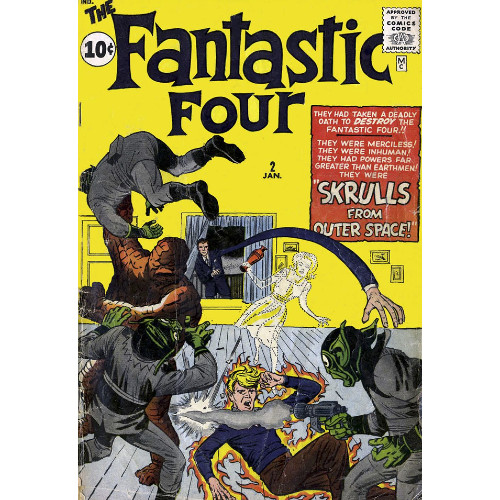
"Embrace Change."
So demanded a marketing campaign Marvel debuted to promote their 2008 crossover event, Secret Invasion, which would go on to inspire the MCU limited series on Disney+ several years later. The campaign included images of humans and alien Skrulls cohabitating–a little Skrull girl eating ice cream with her human friends, a Skrull woman hugging her human husband/boyfriend. The campaign teased the crossover's story: that the Skrulls had, for years, been hiding among humanity, preparing for a–you guessed it–secret invasion.
Readers could track the inception for the invasion backwards, starting with the destruction of the Skrull's homeworld during Annihilation, then hopping back to the Kree-Skrull War in the pages of Roy Thomas' Avengers. Not that seeds had been intentionally sown since the 70s to build up to this event, but the path leading to the present could be found.
Today, we're casting ourselves even further back, beyond the Kree-Skrull War, to the very first appearance of those shapeshifting extraterrestrials. In the second ever issue of Fantastic Four, Stan Lee and Jack Kirby introduced audiences to a brand new race of aliens…and, seemingly unintentionally, expanded the scope of Marvel Comics beyond Earth, out into a vast universe humanity and superhumanity were only beginning to realize they belonged to.
"The Fantastic Four Meet the Skrulls from Outer Space"
Writer: Stan Lee
Penciler: Jack Kirby
Inker: George Klein
Colorist: Stan Goldberg
Letterer: Joe Duffy
Issue: Fantastic Four #2
Issue Publication Date: January 1962
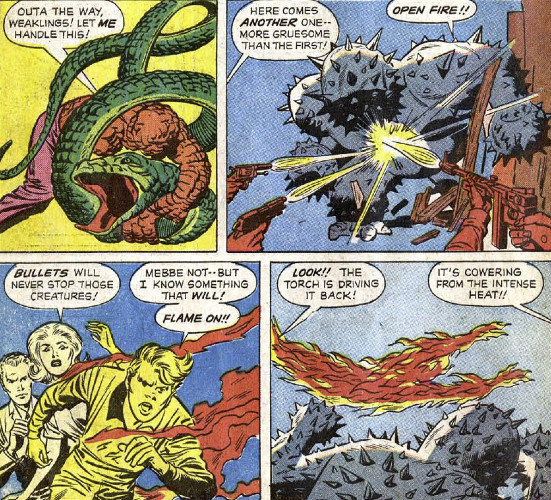
I don't believe Stan Lee and Jack Kirby, when they invented the Skrulls, were actively attempting to broaden the horizons of Marvel Comics into a Marvel Universe (a transition, I've heard argued, which really happened with the Kree-Skrull War). Science fiction was a major influence on these early issues–Spider-Man fought "aliens" (later revealed to be criminals in disguise, but I believe they were meant to be aliens initially) in his second issue, as did the Hulk. How many times did comic covers sport blurbs about "The Things from Planet X!" or trips to other worlds? In an America where real fears of war, nuclear devastation, and invasion flitted through daily living, it's no wonder such stories proliferated–if you don't want to be so blunt as to have the Fantastic Four face Russian enemies (though they'd eventually do that…), you may as well take the parable route and apply those fears to creatures from a different planet.
Picture an alien armada descending upon your nation, city, or hometown. Worse, imagine if those aliens first infiltrated secretly and assumed the visage of your most popular people, discrediting your first line of defense against their machinations. That's exactly what the Skrulls intend in this issue…by impersonating the Fantastic Four! It's a simple narrative, and if its intent was to tap into Cold War terrors on some level, it's none too preachy, which I appreciate. Spies from hostile forces in disguise, performing seemingly random acts of terrorism as a prelude to a larger invading army? The connections aren't complicated, and perhaps not apparent to younger readers, but the possible real world inspirations for this issue aren't exactly as hidden as a Skrull impersonator.
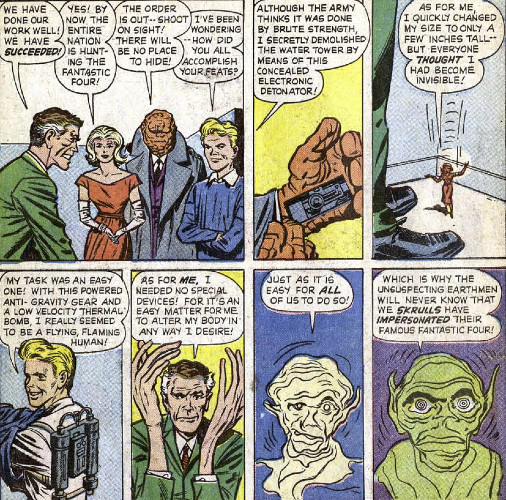
Over anything else, Fantastic Four #2 shows that Lee and Kirby possessed a rough indication of who their characters were and how they'd interact with an unfair world, forming a foundation for further development across the decades. I discussed a similar theme in reviewing Amazing Spider-Man #2, that Lee and penciler/co-storyteller Steve Ditko were finding their way, sometimes fumbling along like someone hunting for a pair of glasses they'd lost, but always earnest. This second FF issue feels similar, with plot points and character pieces introduced which feel like a testing ground for later narratives. How well does this bit hold up? you can picture the men asking themselves. How will readers react to this?
Take the Skrulls themselves, f'rinstance. A panel near the issue's end has one of the FF impersonators note how their little group actually "hate[s] being Skrulls" and would "rather be anything else!" It's an interesting line, indicating that these four aren't exactly aligned with their militant masters, but it comes out of nowhere two panels before the issue ends. Such discontent has not been mentioned before, and without any time to elaborate before the issue wraps up, isn't allowed to develop. The thought lingers, and an attempt to provide these malcontents any personalities beyond "flavor of the month bad guys" is lost.
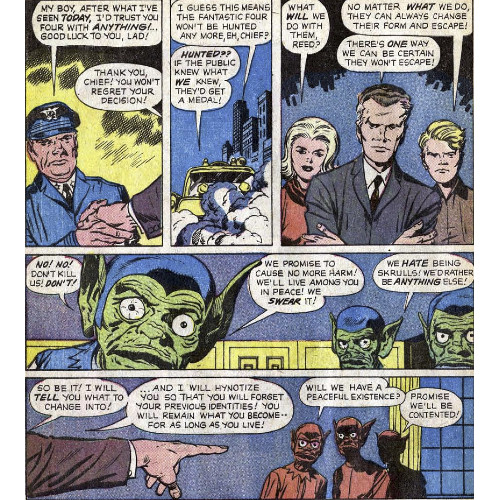
A sequence where the FF descend from space introduces a development which will become an ongoing development. Brought into contact with the same cosmic ray belt which gave the FF their powers, the Thing is transformed momentarily back into Ben Grimm. The change doesn't last; a few pages later, he's back to his orange, creviced self. These moments are small, but they promise progress the Skrulls are unable to have. "That might mean the power of the cosmic rays is growing weaker," Sue Storm posits, noting Ben may someday resume his human form permanently. While 60+ years of storytelling have stalled her prediction from being fulfilled, Ben's temporary lapses into humanity have become a central theme for the character, reinforcing his struggle to regain the form he lost.
The other FF members receive a few additional defining characteristics. Reed is presented as calculating…and not just with mathematical formulas. Mr. Fantastic's social intelligence has wavered throughout the decades, but here, he's presented as not just the smartest man intellectually but also capable of reading, and controlling, any situation he enters. He interrogates the Skrulls with a gun, physically restrains and attempts to reason with Ben, tricks the Skrull armada leader into believing he and the rest of the Four are fellow Skrulls while discouraging an invasion of Earth. "They masqueraded as us," he tells his team in one panel, half of his face wonderfully covered in shadow. "Now we must pose as them."
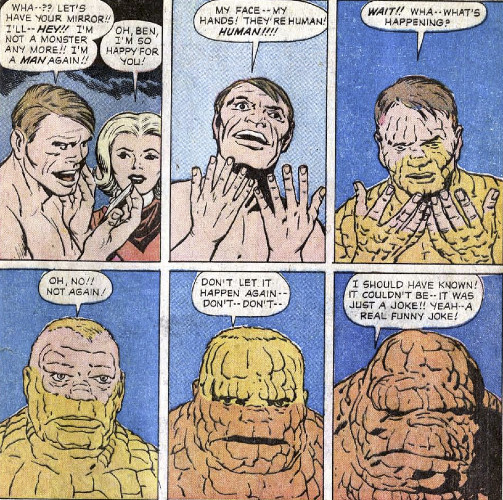
Johnny is rendered as his typical hot-headed self, particularly in one panel where he (literally) flares up against the Thing. He takes risks, infiltrates the Skrull crew, yet offers encouragement to his friends when they need it. Sue shows compassion and concern to her teammates yet does little else besides. A visually fun sequence where the team escapes a military compound has Reed contort his body, Johnny burn through walls, Ben smash through his cell…and Sue sneak past her guards somewhat unsuccessfully. Her power is more defensive than anything else, and she's not as physically powerful as her male counterparts (though she does trip a Skrull while invisible at one point...yay, progress?). This changes over time, of course, but for now, she sneaks and slips away, invisible in more ways than one.
These personalities also help form the bedrock of what will be important character interactions between our heroes. Already, we see how Johnny's impulsive youthfulness grates with Ben's own stubborn temperament. Reed sits in the guilt of how his actions transformed Ben, stole his humanity. And as I noted, Sue plays the peacemaker, forming a counterpart to Reed's somewhat cold responses. Where Reed attempts to separate the squabbling Thing and Torch through blunt reason, Sue's response is gentler, more empathetic and understanding. I know folks have complained that she's a stereotypical female character–soft spoken, quiet, demure–but she behaves as the glue here which keeps the men together, even as a salve which soothes wounds.
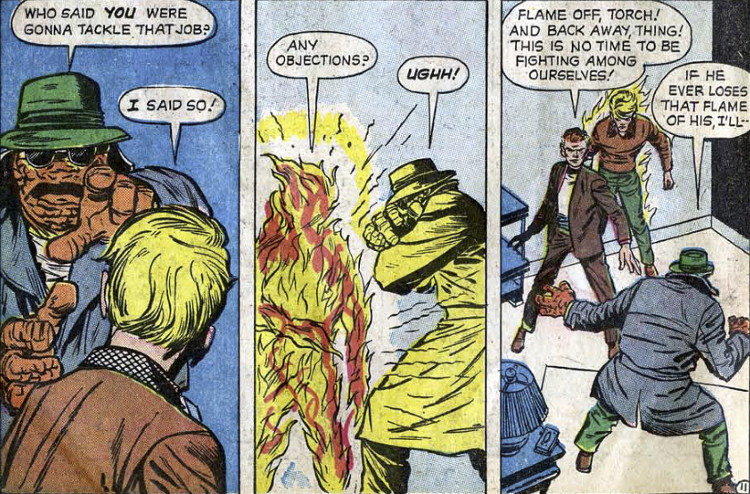
Lee and Kirby continue to treat the series as something different from your standard superhero comic, and nowhere is this evidenced better than the first time we see the Four, on the lam after the Skrull's tactics have put them on the outs with the law. In a rustic cabin, the four adventurers wallow in worry, dressed in their "civvies." No fancy costumes or secret base for these heroes. Reed does have a "costume change" later in the issue, but I don't think either "plaid shirt and brown slacks" or "brown business suit" will become alternate skin options in Marvel Rivals anytime soon. They're fairly pedestrian, our heroes, and the only reason they fight the Skrulls to begin with is to clear their names. They save Earth, but that comes about as a happy accident, a side effect of tracking their impersonators. And they don't deter the invasion through crushing waves of Skrull warriors; Reed shows the armada leader clippings from Marvel monster magazines, a great little gag which also works effectively.
The basics are all here: the foundational character elements, the humanness of our heroes, the relationships which will continue growing over the decades. Want to see where Ben and Johnny's "sibling rivalry" relationship began? Look here. Wonder when Reed began holding himself accountable for Ben's condition? Check out this issue. This is where Lee and Kirby introduced Marvel's popular brand of relatability with their heroes–characters hunted and on the run, characters bemoaning the circumstances which led to their conditions, characters regretting the consequences of their actions…and characters who fight, regardless of the odds, characters who stand for the betterment of a humanity which may not fully trust them, characters who don't become wrapped in their sorrow but instead use the uniqueness of their circumstances to carve new paths forward.
"Embrace change," indeed.